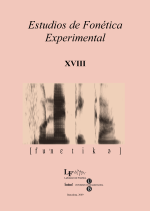/tl/ en español mexicano. ¿Un segmento o dos?
Keywords:
consonant clusters, Mexican Spanish, syllable structureAbstract
In Mexican Spanish the lexical frequency of /tl/ is much higher than in Peninsular Spanish, since it appears in a sizeable number of borrowings and toponyms from Nahuatl. The distribution of /tl/ in Mexican Spanish raises the question of whether /tl/ is actually better viewed a single segment in this Spanish variety (a stop with lateral release, like in Nahuatl), rather than as a sequence of segments, as in Peninsular Spanish. In this paper we test the hypothesis that /tl/ is monosegmental in Mexican Spanish. Our assumption is that reduced duration of /tl/ with respect to similar groups such as /pl/ and /kl/ would provide evidence for monosegmentalism. The experimental results do not offer support for the monosegmental hypothesis. Instead, they serve to establish that /tl/ is, in fact, an onset cluster in Mexican Spanish, not significantly different in its duration from other clusters. Interestingly, but not unexpectedly, word-medial /tl/ is shorter in Castilian than in Mexican Spanish. This follows from a well-known difference in syllabification between the two dialects. In conclusion, /tl/ is an onset cluster in Mexican Spanish, both word- initially and word-medially. In Castilian Spanish, on the other hand, it can only be a heterosyllabic group.
References
BROCKWAY, E. (1979): «North Puebla Nahuatl», en R. Langacker (ed.): Studies in Uto-Aztecan Grammar, vol. 2, Modern Aztec Grammatical Sketches, Arlington, Texas, SIL & U Texas at Arlington, pp. 141-198.
BELLER, R. y P. BELLER (1979): «Huasteca Nahuatl», en R. Langacker, (ed.): Studies in Uto-Aztecan Grammar, vol. 2, Modern Aztec Grammatical Sketches, Arlington, Texas, SIL & U Texas at Arlington, pp. 199-306.
GONZÁLEZ, C. (2002): «Phonetic variation in voiced obstruents in North Central Peninsular Spanish», Journal of the International Phonetic Association, 32,1, pp. 18-31
HARRIS, J. (1983): Syllable structure and stress in Spanish, Cambridge, Mass., MIT Press.
LANGACKER, R. (ed.) (1979): Studies in Uto-Aztecan Grammar, vol. 2, Modern Aztec Grammatical Sketches. Arlington, Texas, SIL & U Texas at Arlington.
MANASTER RAMER, A. (1996): «On Whorf’s Law and related questions of Aztecan phonology and etymology», International Journal of American Linguistics, 69, pp. 176-187.
PENNY, R. (2000): Variation and change in Spanish, Cambridge, Cambridge University Press.
QUILIS, A. (1993): Tratado de fonología y fonética españolas, Madrid, Gredos. TUGGY, D. (1979): «Telecingo Nahuatl», en R. Langacker (ed.): Studies in Uto-Aztecan Grammar, vol. 2, Modern Aztec Grammatical Sketches. Arlington, Texas, SIL & U Texas at Arlington, pp. 1-140.
ZAMORA MUNNÉ, J. C. y J. M. GUITART (1982): Dialectología hispanoamericana: Teoría. Descripción. Historia, Salamanca, Almar.
Downloads
Published
How to Cite
Issue
Section
License

This work is licensed under a Creative Commons Attribution-NonCommercial-NoDerivatives 4.0 International License.
All articles published online by Estudios de Fonética Experimental are licensed under Creative Commons Attribution-NonCommercial-NoDerivs 4.0 International (CC BY-NC-ND 4.0 DEED), unless otherwise noted. Estudios de Fonética Experimental is an open access journal. Estudios de Fonética Experimental is hosted by RCUB (Revistes Científiques de la Universitat de Barcelona), powered by Open Journal Systems (OJS) software. The copyright is not transferred to the journal: authors hold the copyright and publishing rights without restrictions. The author is free to use and distribute pre and post-prints versions of his/her article. However, preprint versions are regarded as a work-in-progress version used as internal communication with the authors, and we prefer to share postprint versions.




